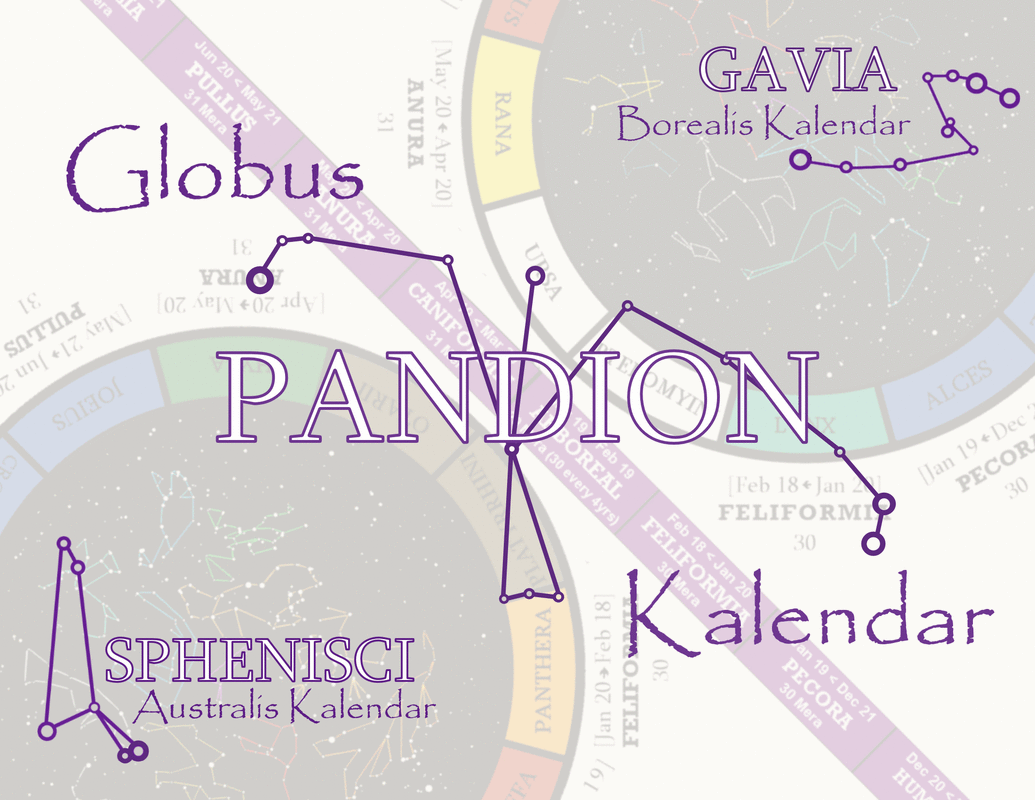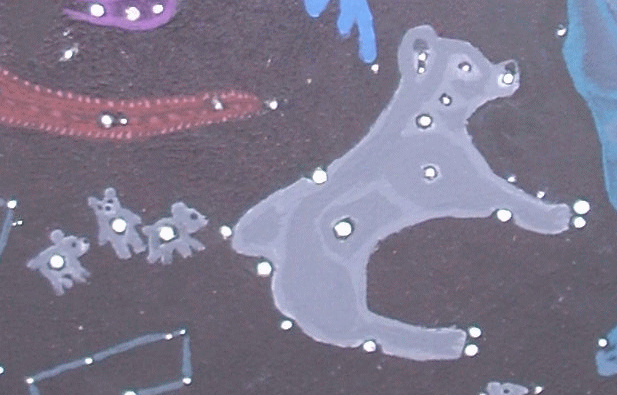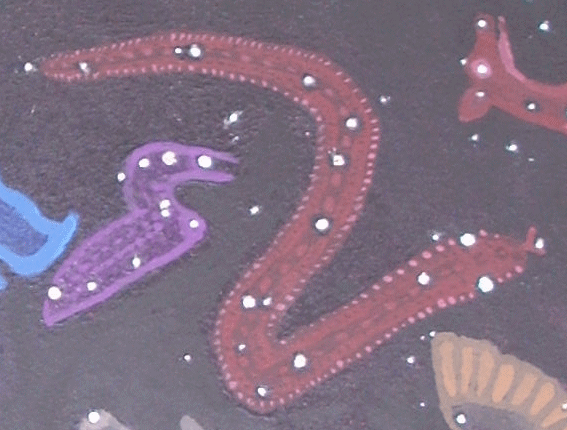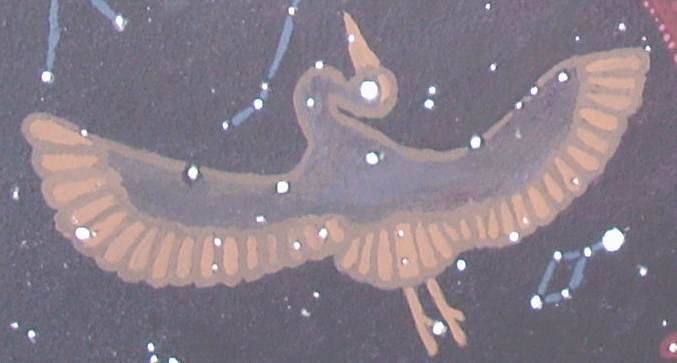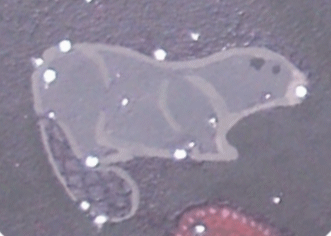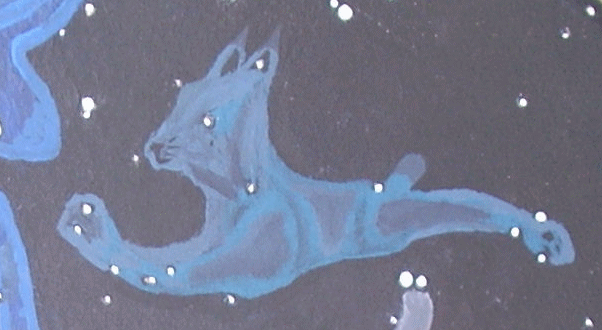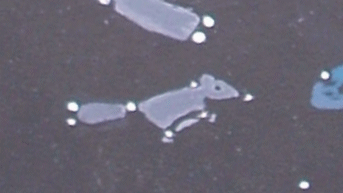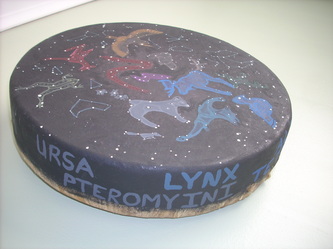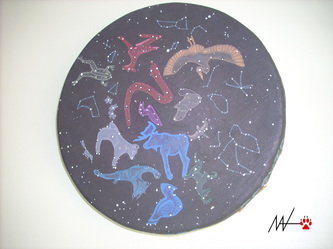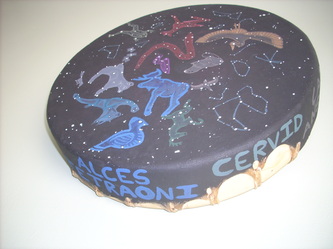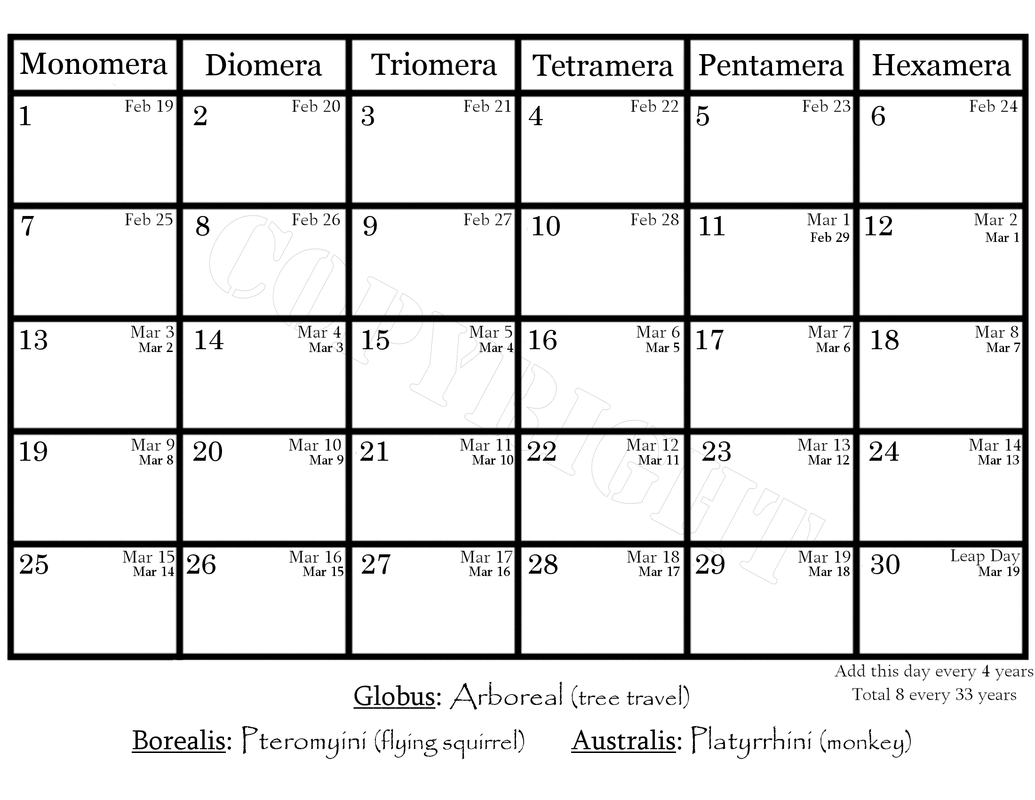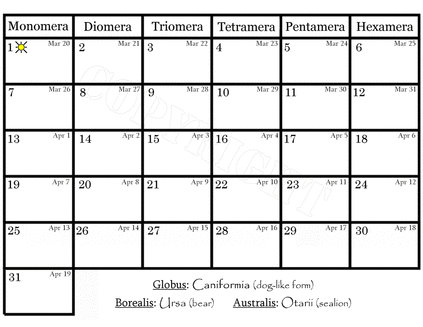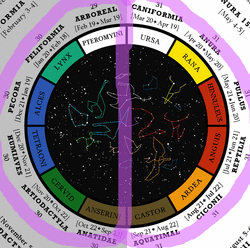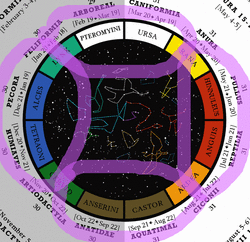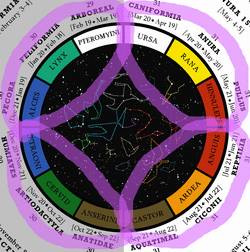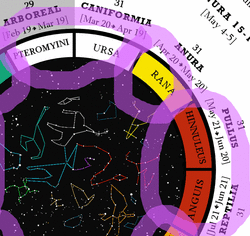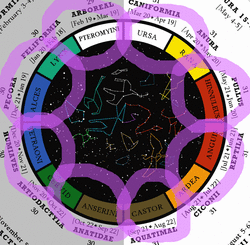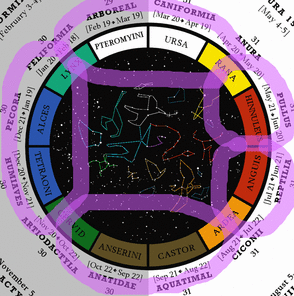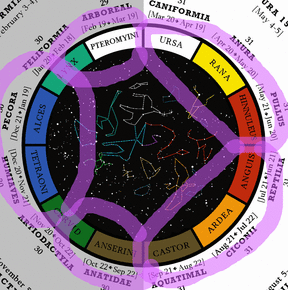© Rua Lupa
The image at the top of the page is Gavia, the Borealis (northern hemisphere) Kalendar/year wheel. It is a solar calendar of 365 days a year with one day added every four years. That one day would be added to the end of Pteromyini (flying squirrel). The year begins on the Equilux (vernal equinox) on Caniformia 1. Over a period of 33 years, only 8 leap years occur to maintain long term accuracy.
The center constellation that contains Polaris (North Star) is Gavia (Loon/Diver). All the other constellations and year revolves around this constellation. It was named after the loon not just because it can only be found in the northern hemisphere, but because of the rare evolutionary path this species has taken; From the ocean whence all creatures came, onto the land, into the sky, and back to the water again. A full circle, like the revolution of the earth, moon and stars. Hence the Borealis Year Wheel being named after it.
The names of each mensis (kalendar month) derives from the constellation that is in the center of the borealis sky that time of year, which is named after an animal that is noticeably active during that same time of year, all of whom reside throughout the Northern Hemisphere.
Here are the names of each mensis and its translation from the beginning of the year to the end. The format is of Pandion (globus name): Gavia (borealis name), and description of animal activities this time of year
Here are the names of each mensis and its translation from the beginning of the year to the end. The format is of Pandion (globus name): Gavia (borealis name), and description of animal activities this time of year
|
Caniformia (Dog-like): Ursa (Bear), Coming out of den with cubs Anura (Frog): Rana (Pond Frog), First calls heard Pullus (Young animal): Hinnuleus (Fawn), Fawns being born Reptilia (Reptile): Anguis (Grass Snake), Shedding snakes and shed skins often found Ciconii (Large Longlegged Wading Birds): Ardea (Great Heron), Last of fledgelings take flight Aquatimal (Aquatic animal): Castor (Beaver), Beaver builds lodge Anatidae (Ducks, Geese & Swans): Anserini (Goose), Geese Migrate South Artiodactyla (Even-toed ungulate): Cervid (Deer), Deer in Rut Humiaves (Ground Birds): Tetraoni (Grouse), bird that remains and is active overwinter Pecora (Hoofed Mammal): Alces (Moose), Antlers shed, and active in winter Feliformia (Cat-like): Lynx (Lynx), winter active species, and mating season for many species of lynx Arboreal (Tree travel): Pteromyini (Flying Squirrel), Active all year long, beginning of mating season |
MENSIS & HEBDO, The Kalendar Month & Week in Detail
There are 6 days in a week (called hebdo to emphasis this difference), and every mensis (month) begins on the same day of the week, Monomera (day one). In the top right corners is the equivalent day in the Gregorian calendar.
There are 6 days in a week (called hebdo to emphasis this difference), and every mensis (month) begins on the same day of the week, Monomera (day one). In the top right corners is the equivalent day in the Gregorian calendar.
|
A typical mensis of the Borealis 'night half' of the year (between the equinoxes) has 30 days in a month, with the exception of the last mensis in the year, being the one depicted, having 29 days in a common month and 30 every four years with a total of 8 leap years every 33 years.
|
This is a typical mensis of the Borealis 'day half' of the year (between the equinoxes) with 31 days in a month. Even with the additional last day on Monomera, it is considered an extra day as a day off, with the following month starting on Monomera as if the last day didn't take that space. This removes the conventional shift in days of the week typical in the Gregorian calendar, making this kalendar perpetual as it never needs to be replaced because the days of the week never shift.
|
Ways of Interpreting Seasons: Tempus Types
Luxnox Tempus
The four images of the sun represent the four major solar changes of the year in the form of the four changes of a day:
|
|
They are named as such because half the the year is dark (represented by a grey background and is called the 'Nox Mensis' - the months of dark) and the other half of the year is light (represented by a white background and is called the 'Lux Mensis' - the months of light), like that of night and day, creating a two season divide of light and dark. |
|
Transmera Tempus
The span between each Transmera (transition day) from the day of Transequilux (transition to vernal equinox) to the day of Translux (Transition to summer solstice) for example, can be considered the Vernus Tempus (spring season). Groupings like this are called Transmera Tempus (Transition day seasons). Having four seasons a year. It can also be considered as the four times of day: Dawn, Day, Dusk, and Night. |
|
|
|
Trimensis Tempus
An alternative way of looking at four seasons, especially for far temperate regions that are closer to the poles, is by separating the mensis by the solar changes so that they are in groups of three, i.e. Ursa, Rana & Hinnuleus. This is called a Trimensis (three months) and each trimensis can be considered a season in it of itself, i.e. Ursa (Late Spring), Rana (Transition between Spring & Summer), & Hinnuleus (Early Summer) is the Vernal Trimensis (the three months of spring) and Anguis (Late Summer), Ardea (Transition between Summer & Fall), & Castor (Early Fall) is the Aestus Trimensis (three months of summer). |
|
Solaris Tempus
You will also see that each solar change has the same colour on either side of it. The two adjacent mensis of the same colour can represent a season, a single mensis with none of the same colours beside it would be considered transitions between each season - potentially being a season in itself. For example, the two white mensis of Pteromyini & Ursa would represent spring; the yellow mensis of Rana would then the transition to summer, and the red mensis of Hinnuleus & Anguis would then be summer. |
|
Combining Different Tempus Types
Depending on your regional climate having the entire year using one tempus type may not make sense. This is when you can combine different tempus types. Here are a couple examples:
Depending on your regional climate having the entire year using one tempus type may not make sense. This is when you can combine different tempus types. Here are a couple examples:

